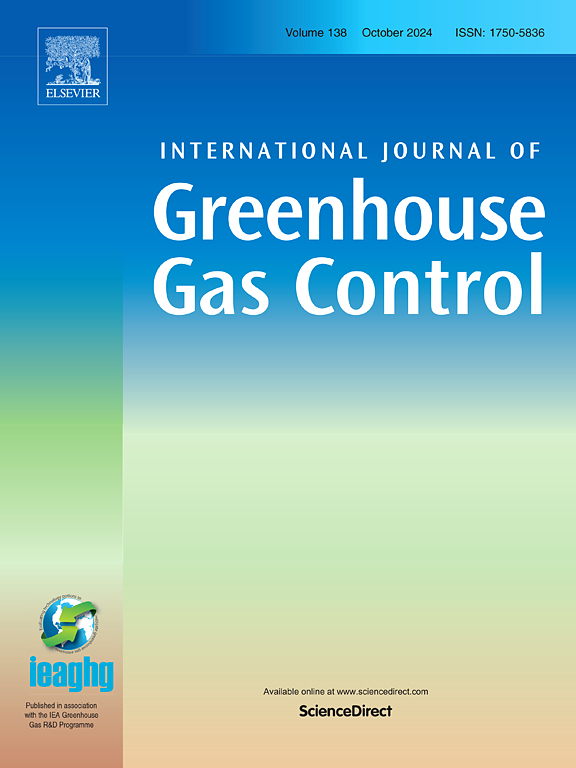Determining alkalinity, carbon loading, and degradation of aqueous amine in CO2 capture processes using heuristic methods
IF 5.2
3区 工程技术
Q2 ENERGY & FUELS
International Journal of Greenhouse Gas Control
Pub Date : 2025-05-09
DOI:10.1016/j.ijggc.2025.104394
引用次数: 0
Abstract
In-line process measurements of pH, temperature, density, and viscosity can be used as inputs for heuristic models to provide an accurate calculation of alkalinity, carbon loading, and degradation of amine solvents used in CO2 capture processes. The accuracy of calculated alkalinity and carbon loading is comparable to repeated off-line sample analyses with similar measurement variations. By incorporating these models into process control software, real-time monitoring of critical physical parameters can be achieved. This can allow for fast process optimization, neural network integration, and instantaneous feedback without the need for regular, costly, and arduous off-line analysis. The aim of this paper is to lay the foundational groundwork for advanced process control schemes for CO2 capture processes with a focus on dynamic operation to match production demands. The models follow amine chemistry, as an amine solvent captures CO2, its carbon loading increases, pH decreases, and density increases. Adjusting for temperature, a correlation can be made between carbon loading and pH. Alkalinity can be calculated by correlating density, temperature, and the carbon loading model output. Total degradation can be calculated with viscosity measurements and alkalinity model outputs, with comparison to known results. Using least-squared methods, the carbon to nitrogen ratio (C/N), alkalinity, and degradation calculations were found to be within 7.27 %, 4.02 %, and ± 2000 ppm of the measured values, respectively. These models have been implemented at the UK 0.7 MWe small pilot CO2 capture plant and were successful in delivering accurate real-time calculations.
测定碱度,碳负荷,和降解的水胺在CO2捕获过程中使用启发式方法
在线过程测量的pH值,温度,密度和粘度可以用作启发式模型的输入,以提供碱度,碳负载的准确计算,并在二氧化碳捕获过程中使用的胺溶剂的降解。计算碱度和碳负荷的准确性与重复的离线样品分析具有类似的测量变化相当。通过将这些模型整合到过程控制软件中,可以实现对关键物理参数的实时监控。这可以实现快速流程优化、神经网络集成和即时反馈,而不需要定期、昂贵和费力的离线分析。本文的目的是为二氧化碳捕集过程的先进过程控制方案奠定基础,重点是动态操作,以满足生产需求。模型遵循胺化学,当胺溶剂捕获CO2时,其碳负荷增加,pH值降低,密度增加。调整温度后,碳负荷与ph之间可以建立相关性。碱度可以通过关联密度、温度和碳负荷模型输出来计算。总降解可以通过粘度测量和碱度模型输出来计算,并与已知结果进行比较。利用最小二乘法,碳氮比(C/N)、碱度和降解计算值分别在实测值的7.27%、4.02%和±2000ppm范围内。这些模型已在英国0.7 MWe小型试点二氧化碳捕集厂实施,并成功地提供了准确的实时计算。
本文章由计算机程序翻译,如有差异,请以英文原文为准。
求助全文
约1分钟内获得全文
求助全文
来源期刊
CiteScore
9.20
自引率
10.30%
发文量
199
审稿时长
4.8 months
期刊介绍:
The International Journal of Greenhouse Gas Control is a peer reviewed journal focusing on scientific and engineering developments in greenhouse gas control through capture and storage at large stationary emitters in the power sector and in other major resource, manufacturing and production industries. The Journal covers all greenhouse gas emissions within the power and industrial sectors, and comprises both technical and non-technical related literature in one volume. Original research, review and comments papers are included.

 求助内容:
求助内容: 应助结果提醒方式:
应助结果提醒方式:


